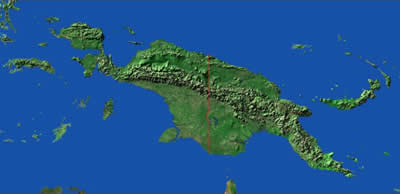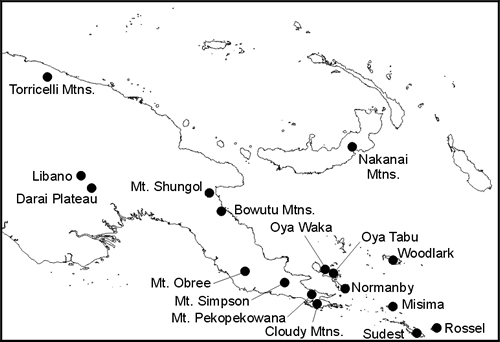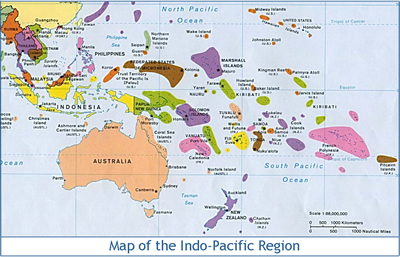• Project • People • Specimens • Taxa • Publications • Bibliography • Related Links • Acknowledgements •
Description of Project
Taxonomic work on the Papuan herpetofauna formally began in 1758 when Linnaeus described two indigenous species of widespread Australasian snakes. The first endemic snake and frog were described by Lesson in 1826, followed by Schlegel's description of the first endemic lizard in 1834. The cumulative number of species increased slowly until the mid-1870s which the pace quickened (see graph below) as biologists began reaching the interior of New Guinea.
There have been about 85 major collecting expeditions to Papua New Guinea since the 1850s, of which about a third were undertaken by the Bishop Museum, beginning in the early 1950s. Most expeditions concentrated on birds, mammals and arthropods, but often made small, opportunistic collections of reptiles, amphibians, and invertebrates. A few expeditions - notably the American Museum's series of Archbold Expeditions, several expeditions undertaken by the South Australian and Australian museums, and about five of the Bishop Museum expeditions - made large collections of reptiles and amphibians, but mostly from limited geographic areas. Beginning around 2000 there has been a marked increase in the rate of species descriptions.
To close gaps in the understanding of this biota, NSF has funded (DEB-0103794 and DEB-0743890) work by Bishop Museum personnel to survey previously unstudied regions of Papua New Guinea. This built on earlier expeditionary and taxonomic research by Bishop Museum personnel. The primary goal of this project has been to increase knowledge of the region's herpetofauna, but logistical support is provided to a team of additional researchers so as to improve our understanding of a diversity of additional vertebrate and invertebrate taxa as well. Additional taxa studied under this effort have included mammals, birds, aquatic insects, landsnails, helminths, and scorpions.
Goals
The goals of the NSF-funded project were to:
- Determine the herpetological diversity of ten unstudied rainforest areas of Papua New Guinea so as to fill in important gaps in herpetological understanding across the country;
- Identify and describe previously undiscovered species encountered during these surveys;
- Obtain new collections of alcoholic and skeletal specimens, frozen tissues, frog call recordings, and photographs for use in resolving outstanding systematic questions in Papuan herpetology, including questions of alpha taxonomy, phylogenetic relationships, and biogeography;
- Make new information on herpetological species composition, abundance, and distribution available to the Government of Papua New Guinea for identifying priority areas for biodiversity conservation;
- Produce identification keys and field guides that will be useful for researchers, land managers, and public educators working in the region;
- Assist officials at the Papua New Guinea National Museum in improving their collections of native reptiles and amphibians and curatorial methods for existing collections;
- Train PNG students in the disciplines of herpetology, field biology, and conservation;
- Provide logistical support to colleagues to collect aquatic Heteroptera, land snails, and other understudied groups for systematic studies.
The Papuan Region
New Guinea and adjacent islands are beset with confusing terminology. We refer to New Guinea as the entire island, including small, biogeographically associated satellite islands. The western half of New Guinea is politically part of Indonesia and is currently divided into Papua and West Irian Jaya provinces but was previously known as Irian Jaya and, prior to that, was Dutch New Guinea. The eastern half of New Guinea is occupied by the sovereign nation of Papua New Guinea, which also includes within its eastern boundaries the Admiralty and Bismarck Archipelagos and Bougainville and Buka islands. These latter two islands, together with a string of high islands and atolls to the SE, comprise the Solomon Islands, which, except for Bougainville and Buka, are politically part of the sovereign nation of the Solomon Islands. The entire area - New Guinea, the Admiralty and Bismarck Archipelagos and the Solomon Islands - is generally called the Papuan region.
The island of New Guinea is often likened to the shape of a bird, with the head consisting of the Vogelkop Peninsula in the far Northwest and the Southeastern Peninsula comprising the tail. A mountain axis runs the length of the island from the northwest to the southeast and divides the island into northern and southern versants. To the north of this Central Dividing Range lies a series of smaller ranges referred to as the northern coastal ranges. These extend from the Vogelkop Peninsula in West Papua Province, Indonesia, to the Huon Peninsula in Morobe Province, Papua New Guinea.
The geological history of the Papuan region is complex, which makes it of great interest for evolutionary studies. The southern half of New Guinea is the northernmost extension of the Australian Craton. Onto this continental margin two separate offshore island arc systems have been sutured by the collision of the Australian and Pacific plates. Approximately 45-50 million years ago, the Papuan Arc system accreted to the northern margin of the Australian Craton, creating what is now the Central Dividing Range. Within the past 10 million years, a second arc system, the Solomons Arc, has collided with New Guinea with a clockwise rotational motion, creating the series of northern coastal ranges. The offshore Bismarck and Solomon island groups are part of this same colliding arc system and are expected to dock with New Guinea over the course of the next several million years. The Southeastern Peninsula is a composite of geological terranes sutured together over a period of several million years and this landmass connected with the main mass of New Guinea approximately 30 million years ago. The separate origin of this peninsula - often referred to as the Southeast Papuan Composite Terrane (SPCT) - means that the Owen Stanley Range, running down the spine of the peninsula, is not part of the main mountainous axis of New Guinea.

This geological history has produced the worlds largest (~890,000 km²) and highest (5,030 m) tropical island, which includes permanent glaciers within 20 km of typical wet tropical lowlands. Its combination of high equatorial temperatures, a variety of rainfall regimes, and rich volcanic soils has resulted in a diverse array of vegetation types dominated by rainforest, but also including mesic forest, seasonal dry forest, savannah, alpine grassland, and tundra. This high habitat (β) diversity and geological amalgamation of separate terranes and island-arc systems has promoted the evolution of an enormous, largely endemic, biota in which closely related species replace one another along altitudinal gradients, as well as across island arc systems, mountain ranges, and adjacent peaks and uplands.
The Papuan region's herpetofauna includes some elements of SE Asian origin and others of Australian origin, with the latter assemblage including ancient Gondwanan elements as well as more recent groups from the north that invaded Australia subsequent to its separation from Antarctica, radiated there, and then dispersed to New Guinea. The Papuan herpetofauna consists of 350 frogs and 400 reptiles (two crocodiles, 17 turtles, 251 lizards, and 130 snakes). This total of 641 species includes 612 terrestrial and freshwater species and 29 marine species. Of the terrestrial species, 82% are endemic to the Papuan region. Most non-endemic species are shared only with Australia. Despite its immense species-level diversity, the herpetofauna of the Papuan region is remarkably limited in reptile and amphibian families, with three frog (Hylidae, Microhylidae, Ranidae), two lizard (Gekkonidae, Scincidae), and two snake (Colubridae, Elapidae) families containing 82% of the species. The remaining families each contain only a few species; these include the frog families Bufonidae (two introduced species) and Myobatrachidae (6 species); the lizard families Agamidae (14), Pygopodidae (2), and Varanidae (8); the turtle families Carettochelidae (1), Chelidae (5), and Trionychidae (2); the crocodile family Crocodylidae (2); and the snake families Acrochordidae (3), Boidae (2), Pythonidae (8), and Typhlopidae (12). Of these families, Hylidae, Myobatrachidae, Chelidae, and Pygopodidae are clearly derived from ancient Australian lineages; Microhylidae, Ranidae, Trionychidae, Colubridae, and Typhlopidae appear to be derived from the Indo-Malayan region; and the remainder are of unclear origin (e.g., Boidae) or represent ancient invasions of New Guinea and Australia from the Orient that subsequently underwent extensive in situ radiation followed by further regional dispersal (e.g., Scincidae). At the generic level, the Papuan herpetofauna is more similar to that of Australia than to that of Southeast Asia. Ten of 31 frog, 4 of 5 turtle, and 20 of 32 lizard genera are shared with Australia. The same numbers shared with southeastern Asia are 5, 1, and 12, respectively.
Areas Surveyed
We have so far been able to survey 17 localities fairly comprehensively (for a period of 10-30 days each). These localities are scattered around Papua New Guinea but concentrated in the Southeastern Peninsula and adjacent islands because of their especially poorly collected history. We intend to survey an additional 15 localities in the next few years.

Survey techniques used at each site included (1) erection of portable drift fences with pitfall traps; (2) placement of glue boards in appropriate microhabitats; (3) search of refuge habitats such as fallen logs, rock piles, arboreal ferns, etc.; (4) visual searches, both by day and by night, for active animals; and (5) tracking of calling frogs.
Taxa Described to Date (July 2011)
Reptiles
Carlia bomberai Zug & Allison, 2006
Carlia caesius Zug & Allison, 2006
Cyrtodactylus epiroticus Kraus, 2008
Cyrtodactylus klugei Kraus, 2008
Cyrtodactylus murua Kraus & Allison, 2006
Cyrtodactylus robustus Kraus, 2008
Cyrtodactylus serratus Kraus, 2007
Cyrtodactylus tripartitus Kraus, 2008
Lobulia alpina Greer, Allison, & Cogger, 2005
Lobulia glacialis Greer, Allison, & Cogger, 2005
Lobulia stellaris Greer, Allison, & Cogger, 2005
Lobulia subalpina Greer, Allison, & Cogger, 2005
Nactus acutus Kraus, 2005
Nactus sphaerodactylodes Kraus, 2005
Toxicocalamus mintoni Kraus, 2010
Toxicocalamus pachysomus Kraus, 2010
Tropidonophis dolasii Kraus & Allison, 2004
Typhlops hades Kraus, 2005
Amphibians
Albericus alpestris Kraus, 2010
Albericus exclamitans Kraus & Allison, 2005
Albericus murritus Kraus and Allison, 2009
Albericus sanguinopictus Kraus & Allison, 2005
Austrochaperina septentrionalis Allison & Kraus, 2003
Callulops eremnosphax Kraus & Allison, 2009
Callulops marmoratus Kraus & Allison, 2003
Callulops omnistriatus Kraus & Allison, 2009
Choerophryne longirostris Kraus & Allison, 2001
Cophixalus bewaniensis Kraus & Allison, 2000
Cophixalus caverniphilus Kraus and Allison, 2009
Cophixalus cupricarenus Kraus & Allison, 2009
Cophixalus desticans Kraus & Allison, 2009
Cophixalus interruptus Kraus & Allison, 2009
Cophixalus iovaorum Kraus & Allison, 2009
Cophixalus kethuk Kraus & Allison, 2009
Cophixalus linnaeus Kraus & Allison, 2009
Cophixalus melanops Kraus & Allison, 2009
Cophixalus phaeobalius Kraus & Allison, 2009
Cophixalus pulchellus Kraus & Allison, 2000
Cophixalus sisyphus Kraus & Allison, 2006
Cophixalus timidus Kraus & Allison, 2006
Cophixalus tomaiodactylus Kraus & Allison, 2009
Cophixalus variabilis Kraus & Allison, 2006
Hylophorbus proekes Kraus & Allison, 2009
Liophryne magnitympanum Kraus & Allison, 2009
Litoria bibonius Kraus & Allison, 2004
Litoria eschata Kraus & Allison, 2009
Litoria flavescens Kraus & Allison, 2004
Litoria rubrops Kraus & Allison, 2004
Mantophryne axanthogaster Kraus & Allison, 2009
Oreophryne anamiatoi Kraus and Allison, 2009
Oreophryne ezra Kraus and Allison, 2009
Paedophyrne Kraus, 2010
Paedophyrne kathismaphlox Kraus, 2010
Paedophyrne oyatabu Kraus 2010
Platymantis browni Allison & Kraus, 2001
Platymantis bufonulus Kraus & Allison, 2007
Platymantis caesiops Kraus & Allison, 2009
Platymantis manus Kraus & Allison, 2009
Platymantis sulcatus Kraus & Allison, 2007
Rana waliesa Kraus and Allison, 2007
Xenorhina adisca Kraus & Allison, 2003
Xenorhina arboricola Allison & Kraus, 2000
Xenorhina zweifeli (Kraus and Allison, 2002)
Helminths
Adenobrechmoinae Bursey, Goldberg, & Kraus, 2006
Adenobrechmos Bursey, Goldberg, & Kraus, 2006
Adenobrechmos greeri Bursey, Goldberg, & Kraus, 2006
Aplectana krausi Bursey & Goldberg, 2007
Cosmocerca zugi Bursey, Goldberg, & Kraus, 2005
Cosmocerca tyleri Bursey, Goldberg, & Kraus, 2006
Falcaustra batrachiensis Bursey, Goldberg, & Kraus, 2009
Falcaustra papuensis Bursey, Goldberg, & Kraus, 2007
Gekkotaenia Bursey, Goldberg, & Kraus, 2005
Gekkotaenia novaeguineaensis Bursey, Goldberg, & Kraus, 2005
Maxvachonia ingens Bursey, Goldberg, & Kraus, 2011
Meteterakis crombiei Bursey, Goldberg, & Kraus, 2005
Moaciria moraveci Bursey, Goldberg, & Kraus, 2007
Parathelandros alllisoni Bursey, Goldberg, & Kraus, 2008
Pharyngodon novaeguineae Bursey, Goldberg, & Kraus, 2008
Physalopteroides milnensis Bursey, Goldberg, & Kraus, 2005
Pseudabbreviata novaeguineaensis Bursey, Goldberg, & Kraus, 2009
Proteocephalus papuensis Bursey, Goldberg, & Kraus, 2008
Raillietnema nanus Bursey, Goldberg, & Kraus, 2006
Rokroknema Bursey, Goldberg, & Kraus, 2009
Rokroknema novaebritanniae Bursey, Goldberg, & Kraus, 2009
Sauracanthorhynchidae Bursey, Goldberg, & Kraus, 2007
Sauracanthorhynchus Bursey, Goldberg, & Kraus, 2007
Sauracanthorhynchus sphenomorphicola Bursey, Goldberg, & Kraus, 2007
Saurokoilophiliinae Bursey, Goldberg, & Kraus, 2008
Saurokoilophilia Bursey, Goldberg, & Kraus, 2008
Saurokoilophilia kinsellai Bursey, Goldberg, & Kraus, 2008
Skrjabinodon derooijae Bursey, Goldberg, & Kraus, 2008
Skrjabinodon sheai Bursey, Goldberg, & Kraus, 2008
Spauligodon zweifeli Bursey, Goldberg, & Kraus, 2005
Zeylanurotrematidae Bursey, Goldberg, & Kraus, 2005
Zeylanurotrema sphenomorphi Bursey, Goldberg, & Kraus, 2005
Landsnails
Paryphantopsis abstrusa Slapcinsky, 2005
Paryphantopsis corolla Slapcinsky & Lasley, 2007
Paryphantopsis fragilicosta Slapcinsky & Lasley, 2007
Paryphantopsis koragae Slapcinsky, 2005
Paryphantopsis lebasii Slapcinsky, 2005
Paryphantopsis matawanensis Slapcinsky, 2005
Paryphantopsis misimensis Slapcinsky, 2006
Paryphantopsis nucella Slapcinsky & Lasley, 2007
Paryphantopsis ubwamensis Slapcinsky, 2005
Paryphantopsis vanatinensis Slapcinsky, 2006
Paryphantopsis yawii Slapcinsky, 2005
Paryphantopsis yelensis Slapcinsky, 2006
Insects
Aegilipsicola auga Polhemus & Polhemus, 2004
Aegilipsicola peninsularis Polhemus & Polhemus, 2004
Argiolestes kula Englund & Polhemus, 2007
Batrachomyia krausi Evenhuis, 2006
Brechivelia Polhemus & Polhemus, 2004
Brechivelia tufi Polhemus & Polhemus, 2004
Halovelia huniye Polhemus & Polhemus, 2006
Halovelia misima Polhemus & Polhemus, 2006
Hermatobates kula Polhemus & Polhemus, 2006
Neusterensifer aviavi Polhemus & Polhemus, 2004
Neusterensifer bowutu Polhemus & Polhemus, 2004
Neusterensifer dentrecasteaux Polhemus & Polhemus, 2004
Neusterensifer femoralis Polhemus & Polhemus, 2004
Neusterensifer goilala Polhemus & Polhemus, 2004
Neusterensifer hunteri Polhemus & Polhemus, 2004
Neusterensifer kula Polhemus & Polhemus, 2004
Neusterensifer louisiadae Polhemus & Polhemus, 2004
Neusterensifer microrivula Polhemus & Polhemus, 2004
Neusterensifer misima Polhemus & Polhemus, 2004
Neusterensifer muyuw Polhemus & Polhemus, 2004
Neusterensifer sagarai Polhemus & Polhemus, 2004
Neusterensifer sulcata Polhemus & Polhemus, 2004
Neusterensifer tufi Polhemus & Polhemus, 2004
Neusterensifer yela Polhemus & Polhemus, 2004
Ocheovelia Polhemus & Polhemus, 2006
Ocheovelia heissi Polhemus & Polhemus, 2006
Pseudagrion fumipenne Polhemus, Michalski, and Richards, 2008
Rheovelia Polhemus & Polhemus, 2004
Rheovelia anomala Polhemus & Polhemus, 2004
Rheovelia asymmetrica Polhemus & Polhemus, 2004
Rheovelia basilaki Polhemus & Polhemus, 2004
Rheovelia fonticola Polhemus & Polhemus, 2004
Rheovelia insularis Polhemus & Polhemus, 2004
Rheovelia petrophila Polhemus & Polhemus, 2004
Rheovelia robinae Polhemus & Polhemus, 2004
Rheovelia truncata Polhemus & Polhemus, 2004
Tanyvelia minima Polhemus & Polhemus, 2004
Tanyvelia papuana Polhemus & Polhemus, 2004
Tanyvelia tagulana Polhemus & Polhemus, 2004
Tarsovelia louisiadensis Polhemus & Polhemus, 2004
Xenobates kanakopi Polhemus & Polhemus, 2006


